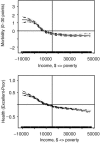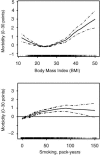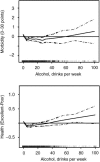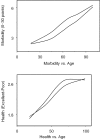Nonlinearity in demographic and behavioral determinants of morbidity
- PMID: 14727798
- PMCID: PMC1360974
- DOI: 10.1111/j.1475-6773.2003.00203.x
Nonlinearity in demographic and behavioral determinants of morbidity
Abstract
Objective: To examine nonlinearity of determinants of morbidity in the United States
Data sources: A secondary analysis of data on individuals with dietary data from the Cancer Epidemiology Supplement and National Health Interview Survey (NHIS) 1987, a cross-sectional, stratified random sample of the U.S. population (n = 22,080).
Study design: A statistical exploration using additive multiple regression models.
Methods: A Morbidity Index (0-30 points), derived from 1987 National Health Interview Survey data, combines number of conditions, hospitalizations, sick days, doctor visits, and degree of disability. Behavioral (health habits) variables were added to multivariate models containing demographic terms, with Morbidity Index and Self-assessed Health outcomes (n = 17,612). Tables and graphs compare models of morbidity with self-assessed health models, with and without behavioral terms. Graphs illustrate curvilinear relationships.
Principal findings: Morbidity and health are associated nonlinearly with age, race, education, and income, as well as alcohol, diet change, vitamin supplement use, body mass index (BMI), marital status/living arrangement, and smoking. Diet change and supplement use, education, income, race/ethnicity, and age relate differently to self-assessed health status than to morbidity. Morbidity is strongly associated with income up to about dollars 15,000 above poverty. Additional income predicts no further reduction in morbidity. Better health is strongly related to both higher income and education. After controlling for income, black race does not predict morbidity, but remains associated with lower self-assessed health.
Conclusions: Good health habits, as captured in these models, are associated with a 10-20-year delay in onset and progression of morbidity.
Figures
Similar articles
-
CDC National Health Report: leading causes of morbidity and mortality and associated behavioral risk and protective factors--United States, 2005-2013.MMWR Suppl. 2014 Oct 31;63(4):3-27. MMWR Suppl. 2014. PMID: 25356673
-
Sociodemographics, self-rated health, and mortality in the US.Soc Sci Med. 2003 Jun;56(12):2505-14. doi: 10.1016/s0277-9536(02)00281-2. Soc Sci Med. 2003. PMID: 12742613
-
Factors associated with self-reported STDs: data from a national survey.Sex Transm Dis. 1994 Nov-Dec;21(6):303-8. doi: 10.1097/00007435-199411000-00002. Sex Transm Dis. 1994. PMID: 7871442
-
Screening and Interventions for Childhood Overweight [Internet].Rockville (MD): Agency for Healthcare Research and Quality (US); 2005 Jul. Rockville (MD): Agency for Healthcare Research and Quality (US); 2005 Jul. PMID: 20722132 Free Books & Documents. Review.
-
Disparities in eye care utilization among the United States adults with visual impairment: findings from the behavioral risk factor surveillance system 2006-2009.Am J Ophthalmol. 2012 Dec;154(6 Suppl):S45-52.e1. doi: 10.1016/j.ajo.2011.09.025. Am J Ophthalmol. 2012. PMID: 23158223 Review.
Cited by
-
Upstream solutions: does the supplemental security income program reduce disability in the elderly?Milbank Q. 2008 Mar;86(1):5-45. doi: 10.1111/j.1468-0009.2007.00512.x. Milbank Q. 2008. PMID: 18307476 Free PMC article.
-
Embracing chaos and complexity: a quantum change for public health.Am J Public Health. 2008 Aug;98(8):1382-9. doi: 10.2105/AJPH.2007.129460. Epub 2008 Jun 12. Am J Public Health. 2008. PMID: 18556599 Free PMC article.
-
Income, education, and inflammation: differential associations in a national probability sample (The MIDUS study).Psychosom Med. 2010 Apr;72(3):290-300. doi: 10.1097/PSY.0b013e3181cfe4c2. Epub 2010 Jan 25. Psychosom Med. 2010. PMID: 20100883 Free PMC article.
-
Do more hospital beds lead to higher hospitalization rates? a spatial examination of Roemer's Law.PLoS One. 2013;8(2):e54900. doi: 10.1371/journal.pone.0054900. Epub 2013 Feb 13. PLoS One. 2013. PMID: 23418432 Free PMC article.
-
A chaotic view of behavior change: a quantum leap for health promotion.Int J Behav Nutr Phys Act. 2006 Sep 12;3:25. doi: 10.1186/1479-5868-3-25. Int J Behav Nutr Phys Act. 2006. PMID: 16968551 Free PMC article.
References
-
- Aday LA. “Indicators and Predictors of Health Services Utilization.”. In: Williams SJ, Torrens PR, editors. Introduction to Health Services. Albany, NY: Delmar; 1993. pp. 46–70. chap. 3.
-
- Adler NE, Ostrove JM. “Socioeconomic Status and Health: What We Know and What We Don't.”. Annals of the New York Academy of Sciences. 1999;896:3–15. - PubMed
-
- Backlund E, Sorlie PD, Johnson NJ. “The Shape of the Relationship between Income and Mortality in the United States: Evidence from The National Longitudinal Mortality Study.”. Annals of Epidemiology. 1996;6:16–20. - PubMed
-
- Breslow L, Breslow N. “Health Practices and Disability: Some Evidence from Alameda County.”. Preventive Medicine. 1993;22(3):86–95. - PubMed
-
- Centers for Disease Control (CDC) “BMI: Body Mass Index for Adults.”. 2003. Available at http://www.cdc.gov/nccdphp/dnpa/bmi/bmi-adult.htm [accessed June 20, 2003]
Publication types
MeSH terms
LinkOut - more resources
Full Text Sources





